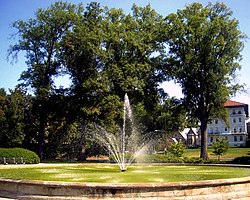Chevy Chase (Washington, D.C.)
| Chevy Chase | |
|---|---|
| Neighborhood of Washington, D.C. | |

The Francis Griffith Newlands Memorial Fountain is located in the center of Chevy Chase Circle.
|
|
 Map of Washington, D.C., with Chevy Chase highlighted in red |
|
| Coordinates: 38°58′22″N 77°03′51″W / 38.9727°N 77.0642°WCoordinates: 38°58′22″N 77°03′51″W / 38.9727°N 77.0642°W | |
| Country | United States |
| District | Washington, D.C. |
| Ward | Ward 3 |
| Government | |
| • Councilmember | Mary Cheh |
Chevy Chase is a neighborhood in northwest Washington, D.C. It borders Chevy Chase, Maryland, a collection of similarly affluent neighborhoods.
The neighborhood is generally agreed to be bounded by Rock Creek Park on the east, Western Avenue (which divides D.C. and Maryland) and Tennyson Street on the north, and Reno Road to the west. Opinions differ on the southern boundary, where Chevy Chase meets Forest Hills, but many residents consider it to be Broad Branch Road between 32nd and 27th streets. The main roads leading in and out of Chevy Chase, D.C. are Connecticut Avenue, Nebraska Avenue, Reno Road, Military Road and Western Avenue. The area is served by the M4, L1, L2, L8, E2 and E6 Metrobus lines. Chevy Chase is within walking distance of three Red Line stations: Van Ness-UDC, Tenleytown-AU, and Friendship Heights. The public schools that serve Chevy Chase are Lafayette Elementary, Ben W. Murch Elementary, Alice Deal Middle School, and Woodrow Wilson Senior High.
In the late 1880s, then-Representative Francis G. Newlands of Nevada and his partners began the aggressive acquisition of farmland in northwest Washington, D.C. and southern Montgomery County, Maryland, for the purpose of developing a residential streetcar suburb. (See Washington streetcars.) They founded the Chevy Chase Land Company in 1890, and its eventual holdings are now known as this neighborhood and Chevy Chase, Maryland. Chevy Chase D.C. was developed beginning in the early 1900s after construction was completed on the Chevy Chase Line, a streetcar line stretching to and beyond the northwestern boundary of the District of Columbia, thereby linking the area to downtown. Over succeeding decades the formerly remote area was transformed from farmland and woods to middle-class housing. The housing stock in Chevy Chase D.C. includes many "Sears Catalog Homes", a popular housing option in the early twentieth century that allowed individuals of modest means to order by mail the materials and instructions for a home and build it themselves.
...
Wikipedia
